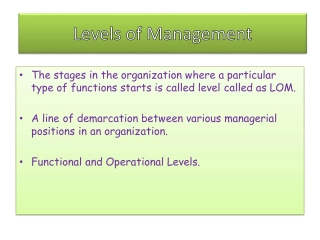Levels of Management in Organizations: Overview and Roles
In the realm of organizational management, understanding the hierarchical levels is crucial. Explore the significance and functions of top, middle, and lower level management. Discover how each level contributes to achieving organizational goals and maintaining efficiency.
Uploaded on Feb 19, 2025 | 0 Views
Download Presentation

Please find below an Image/Link to download the presentation.
The content on the website is provided AS IS for your information and personal use only. It may not be sold, licensed, or shared on other websites without obtaining consent from the author.If you encounter any issues during the download, it is possible that the publisher has removed the file from their server.
You are allowed to download the files provided on this website for personal or commercial use, subject to the condition that they are used lawfully. All files are the property of their respective owners.
The content on the website is provided AS IS for your information and personal use only. It may not be sold, licensed, or shared on other websites without obtaining consent from the author.
E N D
Presentation Transcript
"Many of our satisfaction and frustrations grow out of our participation in groups and our strivings, with others towards group goals". James C. Coleman CHAPTER OUTLINE Introduction Meaning of Levels of Management Top Level Management Lower Level Management Middle Level Management
INTRODUCTION Today, it is the time of big organization scale production. In this age of large scale production and throat cut competition, the ownership and management of organization are divorced. The business is managed by those who are not its owners. In management set up of an organization, we find different levels. Levels of management refer to a line of separation between different positions held by different persons in an organization. In this context, managerial hierarchy is studied. Managerial hierarchy means the study of different positions held by the employees and officers of an organization. It is the structure which makes clear position of all officers of the organization.
MEANING OF LEVELS OF MANAGEMENT The term levels of management refers to a line of separation between different positions held by different persons in an organization. Level of management depends upon the nature, size and functions of an organization. Levels of management also expand with the expansion of organization. There is a limit to the number of subordinates a person can supervise. Levels of management are increased so as to achieve effective supervision. The levels of management of an organization may be broadly be divided in to three parts namely, top management, middle management and lower level or first line management.
1. TOP LEVEL MANAGEMENT Top level management of a company consists of the board of directors and the chief executive or the managing director. Top management is the ultimate source of authority and it establishes goals and policies for the enterprise. It devotes more time for planning and co-ordination functions. The role of top management will be further clear by studying its functions or activities: 1. It lays down the objectives of the enterprise. 2. It prepares strategic plans and policies for the enterprise. 3. It issues necessary instruction for the preparation of departmental budgets, schedules, procedures, etc. 4. It appoints the executives for the middle level. 5. It controls the activities of all departments with the help of reports, memoranda etc. 6. It builds and maintains relations with the outside public.
MIDDLE LEVEL MANAGEMENT Middle level management generally consists of heads of functional departments they are responsible to the top management for the functioning of their departments. They devote more time to the organization and direction function of management. The role played by the middle level executives is stated below: 1. They execute the plans of the organization in accordance with policies and directives of the top management. 2. They make plans for the sub-units of the organization. 3. They participate in the employment and training of the lower-level management. 4. They attempt to achieve coordination between different departments.
5. 6. They evaluate the performance of junior managers. They send the progress reports and other important data to the top management. LOWER LEVEL MANAGEMENT (SUPERVISORY LEVEL) Lower level management is also known as supervisory management because it is directly concerned with the control of performance of the operative employees. This level includes supervisors, foremen, accounts officers, sales officers, and so on. They devote more time on the supervision of workers. The important functions of a supervisor or lower level executive are listed below:
1. 2. To plan and organize the activities of the group. To arrange for necessary materials, machines, tools etc. for the workers and to provide them necessary working environment. To provide training to the workers. To supervise and guide subordinates. To solve problems of workers. To communicate workers problems to the higher level management. To maintain good human relations in the organization. To send periodical reports about performance. 3. 4. 5. 6. 7. 8.























